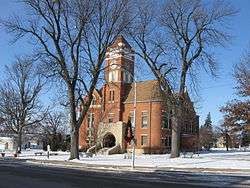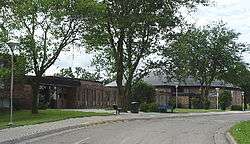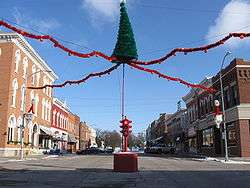Toledo, Iowa
| Toledo, Iowa | |
|---|---|
| City | |
|
Toledo, Iowa | |
 Location of Toledo, Iowa | |
| Coordinates: 41°59′36″N 92°34′45″W / 41.99333°N 92.57917°WCoordinates: 41°59′36″N 92°34′45″W / 41.99333°N 92.57917°W | |
| Country |
|
| State |
|
| County | Tama |
| Government | |
| • Mayor | Dave Svoboda |
| Area[1] | |
| • Total | 2.30 sq mi (5.96 km2) |
| • Land | 2.30 sq mi (5.96 km2) |
| • Water | 0 sq mi (0 km2) |
| Elevation | 906 ft (276 m) |
| Population (2010)[2] | |
| • Total | 2,341 |
| • Estimate (2012[3]) | 2,276 |
| • Density | 1,017.8/sq mi (393.0/km2) |
| Time zone | Central (CST) (UTC-6) |
| • Summer (DST) | CDT (UTC-5) |
| ZIP code | 52342 |
| Area code(s) | 641 |
| FIPS code | 19-78510 |
| GNIS feature ID | 0462271 |
Toledo is a city in and the county seat of Tama County, Iowa, United States.[4] The population was 2,341 at the 2010 census.
History
Toledo was founded in 1853 as the county seat of Tama County.[5] It was named after Toledo, Ohio.[6] Toledo was incorporated as a city in 1866.[5]
Geography
Toledo is located at 41°59′36″N 92°34′45″W / 41.99333°N 92.57917°W (41.993281, -92.579067).[7]
According to the United States Census Bureau, the city has a total area of 2.30 square miles (5.96 km2), all of it land.[1]
Demographics

| Historical populations | ||
|---|---|---|
| Year | Pop. | ±% |
| 1870 | 888 | — |
| 1880 | 1,026 | +15.5% |
| 1890 | 1,836 | +78.9% |
| 1900 | 1,941 | +5.7% |
| 1910 | 1,626 | −16.2% |
| 1920 | 1,604 | −1.4% |
| 1930 | 1,825 | +13.8% |
| 1940 | 2,073 | +13.6% |
| 1950 | 2,106 | +1.6% |
| 1960 | 2,417 | +14.8% |
| 1970 | 2,361 | −2.3% |
| 1980 | 2,455 | +4.0% |
| 1990 | 2,380 | −3.1% |
| 2000 | 2,539 | +6.7% |
| 2010 | 2,341 | −7.8% |
| 2014 | 2,250 | −3.9% |
| 2015 | 2,202 | −2.1% |
| Source:"American FactFinder". United States Census Bureau. and Iowa Data Center Source: | ||
2010 census
As of the census[2] of 2010, there were 2,341 people, 901 households, and 598 families residing in the city. The population density was 1,017.8 inhabitants per square mile (393.0/km2). There were 993 housing units at an average density of 431.7 per square mile (166.7/km2). The racial makeup of the city was 83.5% White, 1.1% African American, 5.8% Native American, 0.6% Asian, 4.3% from other races, and 4.8% from two or more races. Hispanic or Latino of any race were 11.4% of the population.
There were 901 households of which 31.5% had children under the age of 18 living with them, 51.4% were married couples living together, 10.5% had a female householder with no husband present, 4.4% had a male householder with no wife present, and 33.6% were non-families. 28.3% of all households were made up of individuals and 13.3% had someone living alone who was 65 years of age or older. The average household size was 2.43 and the average family size was 2.94.
The median age in the city was 40.3 years. 27.5% of residents were under the age of 18; 6.9% were between the ages of 18 and 24; 21.4% were from 25 to 44; 25.8% were from 45 to 64; and 18.3% were 65 years of age or older. The gender makeup of the city was 46.3% male and 53.7% female.
2000 census
As of the census[9] of 2000, there were 2,539 people, 982 households, and 632 families residing in the city. The population density was 1,105.9 people per square mile (426.2/km²). There were 1,050 housing units at an average density of 457.4 per square mile (176.3/km²). The racial makeup of the city was 87.51% White, 0.51% African American, 5.83% Native American, 0.35% Asian, 0.04% Pacific Islander, 2.91% from other races, and 2.84% from two or more races. Hispanic or Latino of any race were 5.87% of the population.
There were 982 households out of which 30.0% had children under the age of 18 living with them, 49.1% were married couples living together, 12.6% had a female householder with no husband present, and 35.6% were non-families. 30.8% of all households were made up of individuals and 16.6% had someone living alone who was 65 years of age or older. The average household size was 2.36 and the average family size was 2.93.
Age spread: 27.4% under the age of 18, 8.7% from 18 to 24, 24.4% from 25 to 44, 20.1% from 45 to 64, and 19.4% who were 65 years of age or older. The median age was 38 years. For every 100 females there were 84.8 males. For every 100 females age 18 and over, there were 81.9 males.
The median income for a household in the city was $33,750, and the median income for a family was $40,833. Males had a median income of $30,273 versus $22,349 for females. The per capita income for the city was $16,293. About 8.5% of families and 11.0% of the population were below the poverty line, including 17.9% of those under age 18 and 7.0% of those age 65 or over.
Government and infrastructure
The Iowa Department of Human Services operates the Iowa Juvenile Home in Toledo.
Notable people
- Leander Clark, Iowa politician
- King Cole, baseball pitcher, gave up Babe Ruth's first hit
- Michael Emerson, actor
- Norma 'Duffy' Lyon (1929–2011) sculptor nicknamed the "Butter Cow Lady"[10]
- George R. Struble, Iowa judge and politician; speaker of the Iowa House of Representatives, 1881–1883
- John T. Struble, pioneering businessman
- Isaac S. Struble, U.S. Representative
Education

Toledo is home to the South Tama County Community School District, which includes a class 3A high school that enrolls over 430 students, a middle school, and an elementary school that has over 700 students.[11]
Parks and Recreation
Toledo Heights sits on the west side of town. The park has two fields which are used for little-league baseball and softball. The park has a playground and a large picnic shelter. Surrounding the park is an 18-hole disc golf course.
Each summer, the annual Stoplight Festival takes place on the town square. The celebration surrounds the historic stoplight located at the intersection of High Street and Broadway.
Arts
The Wieting Theatre is located in downtown Toledo, one block east of the stoplight and the Tama County Courthouse square, at 101 South Church Street. Since 1960 the theatre has been maintained and operated by the Wieting Theatre Guild, a nonprofit organization of members and volunteers dedicated to keeping the doors of this grand old theatre open for many years to come. Movies play on most Friday, Saturday and Sunday evenings throughout the year. Actors, musicians, singers and dancers of all ages take the stage on numerous other occasions.[12]
Healthcare
Toledo area residents have access to healthcare services at the Deer Creek Health Center or the Tama Medical Center (now a branch of MMSC). When hospitalization is required the closest and most convenient hospital for residents is Grinnell Regional Medical Center or Marshalltown Medical and Surgical Center
References
- 1 2 "US Gazetteer files 2010". United States Census Bureau. Retrieved 2012-05-11.
- 1 2 "American FactFinder". United States Census Bureau. Retrieved 2012-05-11.
- ↑ "Population Estimates". United States Census Bureau. Retrieved 2013-05-23.
- ↑ "Find a County". National Association of Counties. Retrieved 2011-06-07.
- 1 2 Chapman, Samuel D. (1879). History of Tama County, Iowa: Its Cities, Towns and Villages. Toledo Times Office. pp. 201–202.
- ↑ Chicago and North Western Railway Company (1908). A History of the Origin of the Place Names Connected with the Chicago & North Western and Chicago, St. Paul, Minneapolis & Omaha Railways. p. 131.
- ↑ "US Gazetteer files: 2010, 2000, and 1990". United States Census Bureau. 2011-02-12. Retrieved 2011-04-23.
- ↑ "Census of Population and Housing". Census.gov. Retrieved June 4, 2015.
- ↑ "American FactFinder". United States Census Bureau. Retrieved 2008-01-31.
- ↑ Potter, Andrew (June 28, 2011). "Toledo cherishes memories of 'The Butter Cow Lady'". Times-Republican. Retrieved 2011-06-28.
- ↑ "South Tama County Community School District". s-tama.k12.ia.us. 2011. Retrieved February 12, 2011.
- ↑ http://wieting.tamatoledo.com/
External links
| Wikimedia Commons has media related to Toledo, Iowa. |
